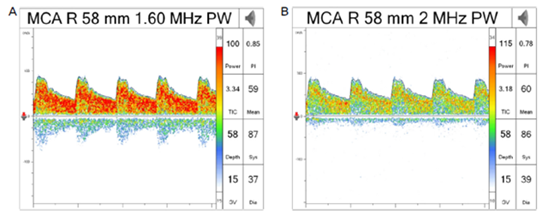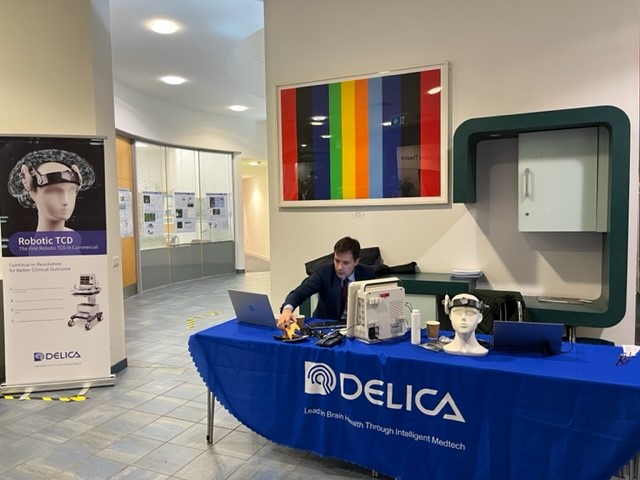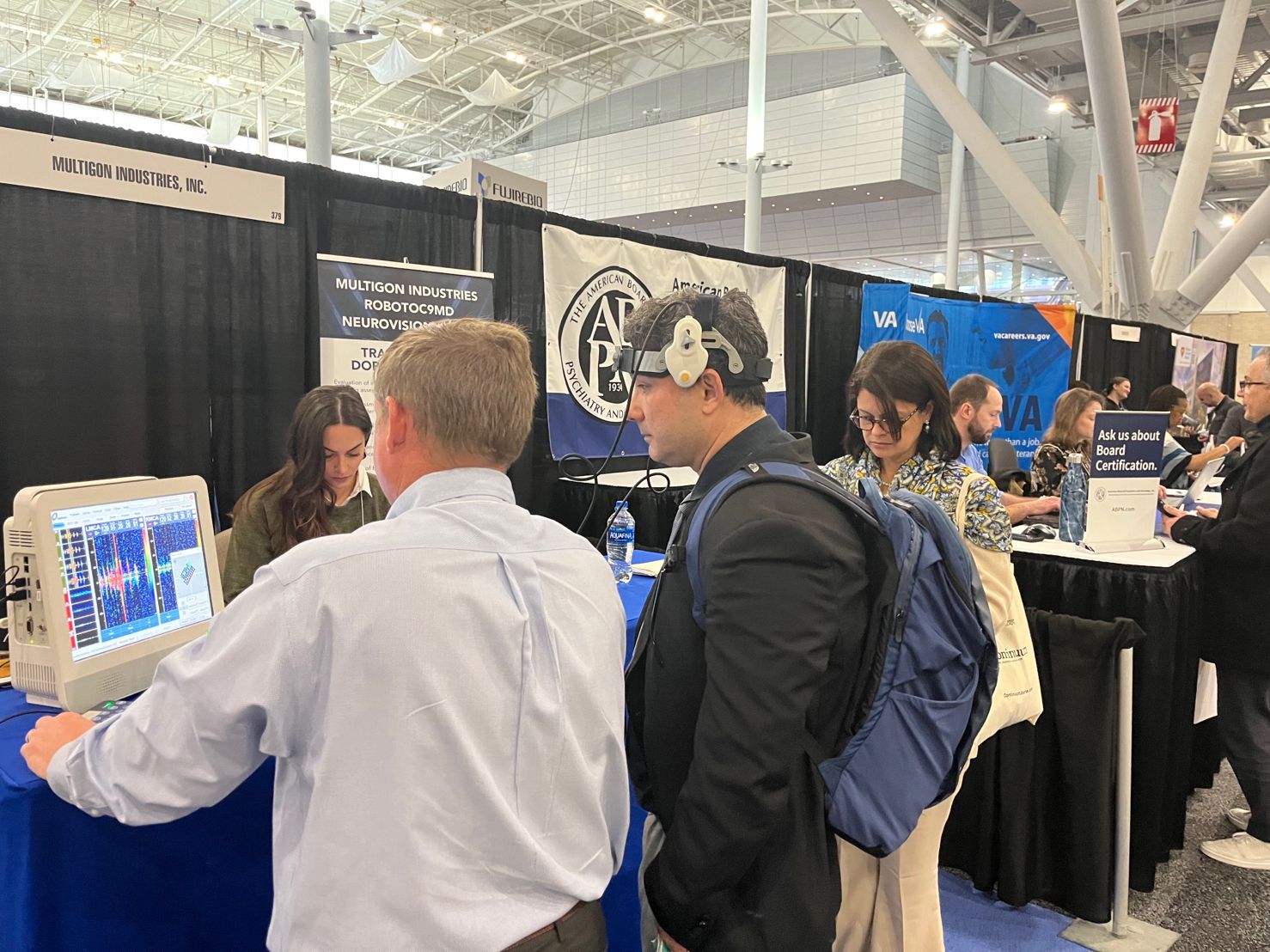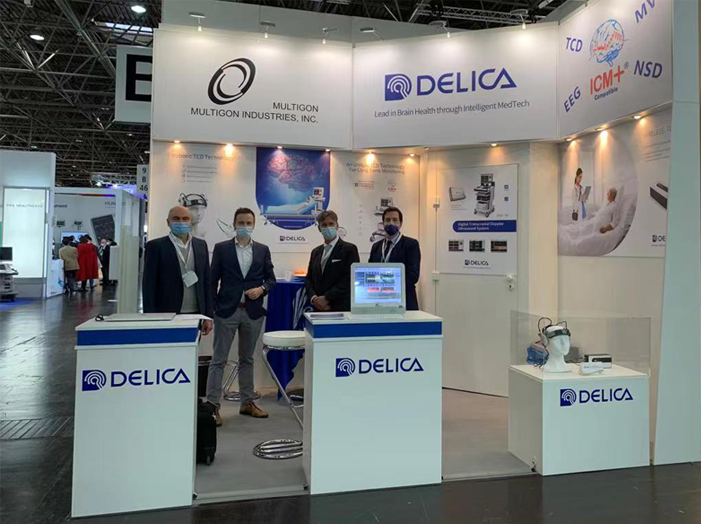The demographics of the stroke population consist mainly of elderly patients. Transcranial Doppler is an effective method for intracranial flow detection, but can be limited due to the poor temporal window (PTW), which is frequent in the elderly. Therefore, we investigated whether the low frequency 1.6-MHz probe can be useful to improve flow detection for PTW.
All 201 participants had a history of transient ischemic attack or minor ischemic stroke. Firstly, we analyzed the success rate of recording intracranial blood flow via temporal window by using 2.0-MHz (high frequency, HF) and 1.6-MHz (low frequency, LF) probes for a maximum of 10 minutes. Secondly, mean flow velocity (MFV) and pulsatile index (PI) of insonated spectrum of 25 patients with good temporal window were compared between the two probes.
Results: Seventy-eight patients were female and the mean age was 64.1±12.4 years. Among 402 windows, 125 (31.1%) were undetected when using the 2.0-MHz probe. Fifty-five patients were detected for the spectrum by the 1.6-MHz probe. However, 70 (17.4%) still remained as PTW. Between the two probes, there were no significant differences of variables from the middle cerebral arteries as below,

Below is Flow spectrum at the same location between 1.6 MHz (A) and 2 MHz (B) probes. Compared to the conventional probes, the 1.6 MHz probe appears to have a higher gain at the same location.

Conclusion: 1.6- MHz probe was feasible to Improve flow detection for PTW which expand the TCD clinical application
Reference: Feasibility of 1.6-MHz Probe for Detection of Cerebral Blood Flow in the Poor Temporal Window.Korean Neurol Assoc 32(1):8-13, 2014
 Delica Distributor Meeting in AmsterdamDelica Medical organized an international distributor meeting in Amsterdam, the Netherlands from April 2nd to 3rd. Nearly 28 participants from Europe and some other countries took part in this meeting.
Delica Distributor Meeting in AmsterdamDelica Medical organized an international distributor meeting in Amsterdam, the Netherlands from April 2nd to 3rd. Nearly 28 participants from Europe and some other countries took part in this meeting. Delica in Medica 2024From November 11 to 14, 2024 Dusseldorf International Medical and Medical Device Fair (MEDICA) was held in Dusseldorf Exhibition Center, Germany.
Delica in Medica 2024From November 11 to 14, 2024 Dusseldorf International Medical and Medical Device Fair (MEDICA) was held in Dusseldorf Exhibition Center, Germany. DELICA made a wonderful appearance in MEDICAFrom November 13 to 16, 2023 Dusseldorf International Medical and Medical Device Fair (MEDICA) was held in Dusseldorf Exhibition Center, Germany.
DELICA made a wonderful appearance in MEDICAFrom November 13 to 16, 2023 Dusseldorf International Medical and Medical Device Fair (MEDICA) was held in Dusseldorf Exhibition Center, Germany. DELICA made a wonderful appearance in the 87th CMEFFrom May 14 to 17, 2023, the 87th China International Medical Equipment Fair (CMEF) was grandly opened in Shanghai National Convention and Exhibition Center. Nearly 5,000 elite enterprises gathered in the event, covering more than 320,000 square meters, nearly 100 conferences and forums, hundreds of special activities, and tens of thousands of products. Industry celebrities and elite gathered in the scene, innovative technology and cutting-edge academic blend here, infinite business opportunitie
DELICA made a wonderful appearance in the 87th CMEFFrom May 14 to 17, 2023, the 87th China International Medical Equipment Fair (CMEF) was grandly opened in Shanghai National Convention and Exhibition Center. Nearly 5,000 elite enterprises gathered in the event, covering more than 320,000 square meters, nearly 100 conferences and forums, hundreds of special activities, and tens of thousands of products. Industry celebrities and elite gathered in the scene, innovative technology and cutting-edge academic blend here, infinite business opportunitie Delica Medical Workshop at Haga Teaching hospitalDelica Workshop at Haga Teaching hospital. Thank you Dr Ruud Keunen for the wonderful lectures!
Delica Medical Workshop at Haga Teaching hospitalDelica Workshop at Haga Teaching hospital. Thank you Dr Ruud Keunen for the wonderful lectures! Delica Medical Participated in CARNET 2022Shenzhen Delica Medical Equipment Co., Ltd. (Delica) Participated in the Cerebrolvascular Research Network (CARNet) meeting in Leicester, UK during 27 th – 29th October 2022.
Delica Medical Participated in CARNET 2022Shenzhen Delica Medical Equipment Co., Ltd. (Delica) Participated in the Cerebrolvascular Research Network (CARNet) meeting in Leicester, UK during 27 th – 29th October 2022. Delica Medical at European Stroke (ESOC) MunichShenzhen Delica Medical Equipment Co., Ltd. (Delica) Participated in the European Stroke (ESOC) 2023 Munich, a lot of interest in High Tech Robotic Probes on Delica TCD
Delica Medical at European Stroke (ESOC) MunichShenzhen Delica Medical Equipment Co., Ltd. (Delica) Participated in the European Stroke (ESOC) 2023 Munich, a lot of interest in High Tech Robotic Probes on Delica TCD Robotic TCD monitoring during TAVI ProcedureTranscranial Doppler(TCD)is a useful diagnostic tool that can be used at bedside to evaluate patients with cerebrovascular disease. As we all know the clinical application from the AAN’s guideline such as Sickle cell screening
Robotic TCD monitoring during TAVI ProcedureTranscranial Doppler(TCD)is a useful diagnostic tool that can be used at bedside to evaluate patients with cerebrovascular disease. As we all know the clinical application from the AAN’s guideline such as Sickle cell screening The 23rd China International HI-TECH FAIRThe 23rd China International HI-TECH FAIR took place in Shenzhen on 27th-29th Dec, 2021 with the theme of advancing high-quality development and fostering a new development pattern.
The 23rd China International HI-TECH FAIRThe 23rd China International HI-TECH FAIR took place in Shenzhen on 27th-29th Dec, 2021 with the theme of advancing high-quality development and fostering a new development pattern. MEDICA 2021, Delica Medical showcases its innovative product .Delica Showcasing Their Latest Generation Product and Technology innovation.
MEDICA 2021, Delica Medical showcases its innovative product .Delica Showcasing Their Latest Generation Product and Technology innovation.